By Carson Meacham, Communications Specialist
Cathy Wade is the co-owner of the F/V Chief Kwina, a 94-year-old wooden ferryboat turned into a fishing tender—a boat that brings catches from fishing boats at sea to processing centers on the mainland—based in Bellingham. According to Cathy, “This boat stands out!” With the ship’s large profile and width designed for cars, it has made for a capable fishing tender in Alaska.
The Chief Kwina was built in 1929 and named for a chief of the Lummi Nation who had died a few years prior. In 1967, Whatcom County retired the vessel from active ferry service when it was replaced by the metal-hulled Whatcom Chief.
According to archived newspapers, in 1970 Whatcom County sold the Chief Kwina to private owners who made extensive repairs and planned to bring it to Sitka, Alaska, to operate as a ferry. In 1998, Cathy and her husband Loren bought the Chief Kwina and brought it back to Whatcom County. The boat required significant modifications to become a fully-fledged fishing vessel, as well as additional repairs from its previous life as a daily ferry. After a few years in dry dock to bring it up to speed, the Chief Kwina has operated almost continuously as a fish tender.
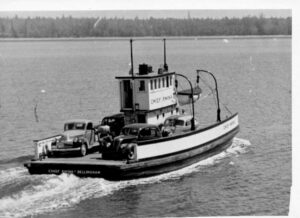
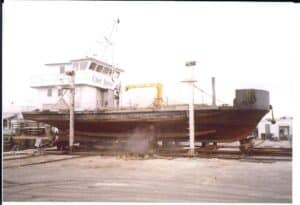
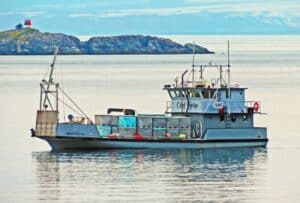
Cathy’s Day
As a fish tender, Cathy worked as the go-between for canneries and commercial fishers for almost 30 years. Her ship carried the fish, crab, and marine products that other vessels would catch from the open sea back to shore where they could be processed for sale.
She also describes herself as “boat mom” for the fishing fleet, baking cookies for visiting fishers while they offloaded their catch and breaking up fights brought on by long months at sea.
Days would begin before dawn for the crew of the Chief Kwina by picking up ice and totes, which help to keep the fish fresher after the catch. “Then we’d find out where the fishermen are at…throw out the hook, anchor up, and wait,” Cathy recalls. Dealing with boredom was a big part of the morning for fish tenders. “You’re either really bored or really busy,” she says.
Soon, the fast work would begin. The Chief Kwina would tie up with a fishing vessel, and “stiff arm” cranes would transport salmon (the main crop of the Chief Kwina) from the fishers to the tender, where they were sorted by species and weighed. Then Cathy would run from the sorting area to the cabin to write out a check for the catch. When finished, she’d give the fishers a treat and send them on their way with a fresh batch of ice for the next day’s catch.
If the Chief Kwina was full of fish, that would mean heading to shore, unloading quickly, and returning to sea—sneaking a nap in where she could, said Cathy.
Fishers from other vessels would occasionally pop in on the Chief Kwina at odd hours. One mariner earned the nickname “Santa Claus” from walking onto the top of their cabin in the middle of the night after some ship problems.
Cathy and her crew worked for a fishing cooperative, which prioritized quality of the fish over quantity. To ensure this higher quality, Cathy and her crew used a more time-intensive process called “belly icing” to keep the catch cooler longer. Belly icing meant the salmon would be gutted, bled, and filled with ice, then packed in ice. Compared to the other common technique of “slush icing” (transporting the whole fish in icy water), it kept the salmon cooler for longer and therefore gave the crew more time on the water, which could mean a better return.
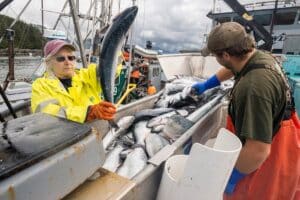
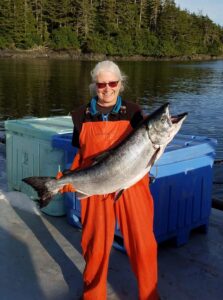
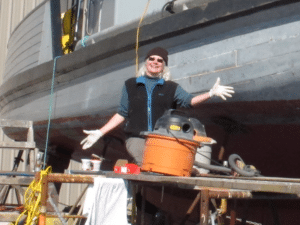
Getting into Advocacy and Looking Back
These days, Cathy is in her 70s and manages a gift shop at the Bellingham Cruise Terminal. While she and her husband Loren still take the Chief Kwina out tendering, their seasons aren’t as long as they once were. Now Cathy also spends time advocating for maritime heritage.
In 2016, a three-year seed grant from the City of Bellingham started SeaFeast, a festival celebrating maritime aquaculture in Bellingham. The founder, Deb Granger, asked Cathy and Loren to serve on the board of the new celebration. With participation from the Port of Bellingham and City of Bellingham as well as Lummi Nation, SeaFeast has grown into an annual two-day festival all about maritime culture.
Cathy has worked hard as a fisher for more than 50 years and says it’s nice to be able to settle down into advocating for maritime culture. She also enjoys the opportunity to do chores on the house, rather than upkeep on the boat.
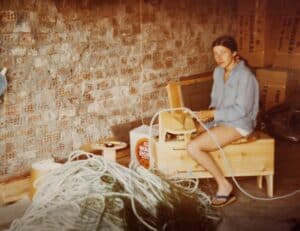
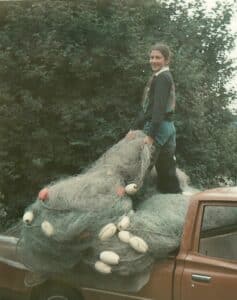
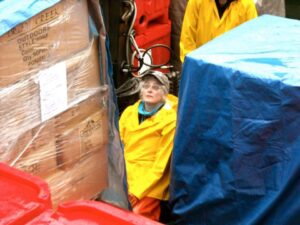
According to Cathy, the quality of the fish has gone up over her years as a fish tender. People’s interest in having high-quality salmon means that while catch quantities have gone down, the salmon that reach tables are better overall.
For young people who might be interested in getting involved with commercial fishing, she says that there is no better way to learn than hands-on experience. It may be a little rough around the edges—Cathy recalled several times when tensions ran high after months at sea—but she believes it’s a rewarding career. “There are a lot of women I’ve met out there that are more capable than a lot of the guys,” said Cathy. She recommends that young women interested in commercial fishing spend time researching their future shipmates to ensure the ship culture is welcoming and respectful.
As we approach the 100th birthday of the Chief Kwina, Cathy and Loren are selling their beloved boat, though Cathy insists it must go to the right person—someone who will use it right and who will take care of it into the future.










